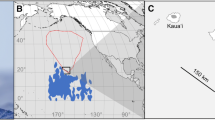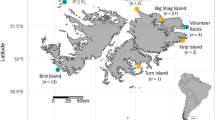Abstract
Intraspecific variation in behavior and diet can have important consequences for population and ecosystem dynamics. Here, we examine how differences in reproductive investment and spatial ecology influence individual diet specialization in male and female southern sea otters (Enhydra lutris nereis). We hypothesize that greater reproductive constraints and smaller home ranges of females lead to more pronounced intraspecific competition and increased specialization. We integrate stable carbon (δ13C) and nitrogen (δ15N) isotope analysis of sea otter vibrissae with long-term observational studies of five subpopulations in California. We define individual diet specialization as low ratios of within-individual variation (WIC) to total population niche width (TNW). We compare isotopic and observational based metrics of WIC/TNW for males and females to data on population densities, and movement patterns using both general linear and linear mixed-effects models. Consistent with our hypothesis, increasing population density is associated with increased individual diet specialization by females but not by males. Additionally, we find the amount of coastline in a sea otter’s home range positively related with individual dietary variability, with increased range span resulting in weaker specialization for both males and females. We attribute our results to sex-based differences in movement, with females needing to specialize in their small ranges to maximize energy gain, and posit that the paradigm of individual prey specialization in sea otters with increased intraspecific competition may be a pattern driven largely by females. Our work highlights a potentially broader role of sex in the mechanistic pressures promoting and maintaining diet specialization.





Similar content being viewed by others
References
Ambrose SH (1990) Preparation and characterization of bone and tooth collagen for isotopic analysis. J Archaeol Sci 17:431–451
Araújo MS, Bolnick DI, Layman CA (2011) The ecological causes of individual specialisation. Ecol Lett 14:948–958. doi:10.1111/j.1461-0248.2011.01662.x
Bateman AJ (1948) Intra-sexual selection in Drosophila. Heredity 2:349–368
Bolnick DI, Yang LH, Fordyce JA, Davis JM, Svanbäck R (2002) Measuring individual-level resource specialisation. Ecology 83:2936–2941
Bolnick DI, Svanbäck R, Fordyca JA, Yang LH, Davis JM, Hulsey D, Forister ML (2003) The ecology of individuals: incidence and implications of individual specialization. Am Nat 161:1–28. doi:10.1086/343878
Bolnick DI, Ingram T, Snowberg LK, Stutz WE, Lau OL, Paull JS (2010) Ecological release from interspecific competition leads to decoupled changes in population and individual niche widths. Proc R Soc Lond B Ser B 277:1789–1797
Caswell H, Neubert MG, Hunter CM (2011) Demography and dispersal: invasion speeds and sensitivity analysis in periodic and stochastic environments. Theor Ecol 4:407–421
Charnov EL (1993) Life history invariants: some explorations of symmetry in evolutionary ecology. Oxford University Press, Oxford
Clutton-Brock TH (1991) The evolution of parental care. Princeton University Press, Princeton
Clutton-Brock TH (2007) Sexual selection in males and females. Science 318(5858):1882–1885. doi:10.1126/science.1133311
Clutton-Brock TH, Coulson TN, Milner-Gulland EJ, Thomson D, Armstrong HM (2002) Sex differences in emigration and mortality affect optimal management of deer populations. Nature 415:633–637
Darimont CT, Paquet PC, Reimchen TE (2009) Landscape heterogeneity and marine subsidy generate extensive intrapopulation niche diversity in a large terrestrial carnivore. J Anim Ecol 78:126–133
Eklov P, Svanbäck R (2006) Predation risk influences adaptive morphological variation in fish populations. Am Nat 167:440–452. doi:10.1086/499544
Estes JA (1980) Enhydra lutris. Mammal Sp 133:1–8
Estes JA, Jameson RJ (1988) A double survey estimate for sighting probability of sea otters in California. J Wildl Manage 52:70–76
Estes JA, Riedman ML, Staedler MM, Tinker MT, Lyon BE (2003) Individual variation in prey selection by sea otters: patterns, causes and implications. J Anim Ecol 72:144–155. doi:10.1046/j.1365-2656.2003.00690.x
Fogel ML, Cifuentes LA (1993) Isotope fractionation during primary production. In: Engel MH, Macko SA (eds) Organic geochemistry. Springer, New York, pp 73-98 doi: 10.1007/978-1-4615-2890-6
Grigione MM, Beier P, Hopkins RA, Neal D, Padley WD, Schonewald CM, Johnson ML (2002) Ecological and allometric determinants of home-range size for mountain lions (Puma concolor). Anim Conserv 5:317–324. doi:10.1017/S1367943002004079
Irschick DJ, Carlisle E, Elstrott J, Ramos M, Buckley C, VanHooydonck B, Meyers JAY, Herrel A (2005) A comparison of habitat use, morphology, clinging performance and escape behaviour among two divergent green anole lizard (Anolis carolinensis) populations. Biol J Linn Soc 85(2):223–234
Jackson AL, Inger R, Parnell AC, Bearhop S (2011) Comparing isotopic niche widths among and within communities: SIBER-Stable Isotope Bayesian Ellipses in R. J Anim Ecol 80:595–602
Jameson RJ (1989) Movements, home range and territories of male sea otters off central California. Mar Mamm Sci 5:159–172. doi:10.1111/j.1748-7692.1989.tb00330.x
Jameson RJ, Johnson AM (1993) Reproductive characteristics of female sea otters. Mar Mamm Sci 9:156–167. doi:10.1111/j.1748-7692.1993.tb00440.x
Kage AH (2004) Temporal and spatial variation in movement patterns of the California sea otter, Enhydra lutris nereis. MS Dissertation. University of California, Santa Cruz, CA
Kelly JF (2000) Stable isotopes of carbon and nitrogen in the study of avian and mammalian trophic ecology. Can J Zool 78:1–27
Kleiman DG (1977) Monogamy in mammals. Q Rev Biol 52:39–69. doi:10.1086/409721
Klein SL, Lambert KG, Durr D, Schaefer T, Waring RE (1994) Influence of environmental enrichment and sex on predator stress response in rats. Physiol Behav 46:291–297. doi:10.1016/0031-9384(94)90197-X
Kondoh M (2003) Foraging adaptation and the relationship between food-web complexity and stability. Science 299(5611):1388–1391
Laidre KL, Jameson RJ, Gurarie E, Jeffries SJ, Allen H (2009) Spatial habitat use patterns of sea otters in coastal Washington. J Mammal 90:906–917
Lima SL, Dill LM (1990) Behavioral decisions made under the risk of predation: a review and prospectus. Can J Zool 68:619–640. doi:10.1139/z90-092
Lindenfors P, Gittleman JL, Jones KE (2007) Sexual size dimorphism in mammals. In: Fairbairn D, Blanckenhorn W, Székely T (eds) Sex evolutionary studies of sexual size dimorphism. Oxford University Press, Oxford, pp 16–26
Loughlin TR (1980) Home range and territoriality of sea otters near Monterey, California. J Wildl Manage 44:576–582. doi:10.2307/3808005
Loveridge AJ, Valeix M, Davidson Z, Murindagomo F, Fritz H, Macdonald DW (2009) Changes in home range size of African lions in relation to pride size and prey biomass in a semi-arid savanna. Ecography 32:953–962. doi:10.1111/j.1600-0587.2009.05745.x
Magurran AE, Nowak MA (1991) Another battle of the sexes: the consequences of sexual asymmetry in mating costs and predation risk in the guppy, Poecilla reticulata. Proc R Soc Lond B 246:31–38. doi:10.1098/rspb.1991.01211471-2954
Millar JS (1977) Adaptive features of mammalian reproduction. Evolution 31:370–386
Newsome SD, Tinker MT, Monson DH, Oftedal OT, Ralls K, Staedler MM, Fogel ML, Estes JA (2009) Using stable isotopes to investigate individual diet specialization in California sea otters (Enhydra lutris nereis). Ecology 90:961–974.
Newsome SD, Bentall GB, Tinker MT, Oftedal OT, Ralls K, Estes JA, Fogel ML (2010) Variation in δ13C and δ15N diet-vibrissae trophic discrimination factors in a wild population of California sea otters. Ecol Appl 20:1744–1752. doi:10.1890/09-1502.1
Newsome SD, Yeakel JD, Wheatley PV, Tinker MT (2012) Tools for quantifying isotopic niche space and dietary variation at the individual and population scale. J Mamm 93(2):329–341
Newsome SD, Tinker MT, Gill VA, Hoyt ZN, Doroff A, Nichol L, Bodkin JL (2015) The interaction of intraspecific competition and habitat on individual diet specialization: a near range-wide examination of sea otters. Oecologia. doi:10.1007/s00442-014-3204-3
Page HM, Reed DC, Brzezinski MA, Melack JM, Dugan JE (2008) Assessing the importance of land and marine sources or organic matter to kelp forest food webs. Mar Ecol Prog Ser 360:47–62
Peacor SD, Pfister CA (2006) Experimental and model analyses of the effects of competition on individual size variation in wood frog (Rana sylvatica) tadpoles. J Anim Ecol 75:990–999. doi:10.1111/j.1365-2656.2006.01119.x
Pearson HC, Packard JM, Davis RW (2006) Territory quality of male sea otters in Prince William Sound, Alaska: relation to body and territory maintenance behaviors. Can J Zool 84:939–946. doi:10.1139/Z06-083
Ralls K (1977) Sexual dimorphism in mammals: avian models and unanswered questions. Am Nat 111:917–938. doi:10.1086/283223
Ralls K, Eagle TC, Siniff DB (1996) Movement and spatial use patterns of California sea otters. Can J Zool 74:1841–1849
Riedman M, Estes JA (1990) The sea otter (Enhydra lutris): behavior, ecology, and natural history. Biol Rep (USA) 90(14)
Riedman ML, Estes JA, Staedler MM, Giles AA, Carlson DR (1994) Breeding patterns and reproductive success of California sea otters. J Wildl Manage 58:391–399. doi:10.2307/3809308
Roughgarden J (1972) Evolution of niche width. Am Nat 106(683):712
Ruckstuhl KE (2007) Sexual segregation in vertebrates: proximate and ultimate causes. Int Comp Biol 47(2):245–257
Staedler MM (2011) Individual variation in maternal care and provisioning in the southern sea otter (Enhydra lutris nereis): causes and consequences of diet specialization in a top predator. MS dissertation, University of California, Santa Cruz
Stander PE (1991) Demography of lions in the Etosha national park, Namibia. Modoqua 18:1–9
Svanbäck R, Bolnick DI (2007) Intraspecific competition drives increased resource use diversity within a natural population. Proc R Soc B 274:839–844. doi:10.1098/rspb.2006.0198
Svanbäck R, Persson L (2009) Population density fluctuations change the selection gradient in Eurasian perch. Am Nat 173(4):507–516
Thometz NM, Tinker MT, Staedler MM, Mayer KA, Williams TM (2014) Energetic demands of immature sea otters from birth to weaning: implications for maternal costs, reproductive behavior and population-level trends. J Exp Biol 217(12):2053–2061
Tinker MT, Doak DF, Estes JA, Hatfield BB, Staedler MM, Bodkin JL (2006) Incorporating diverse data and realistic complexity into demographic estimation procedures for sea otters. Ecol Appl 16:2293–2312
Tinker MT, Bentall G, Estes JA (2008a) Food limitation leads to behavioral diversification and dietary specialization in sea otters. PNAS 105:560–565. doi:10.1073/pnas.0709263105
Tinker MT, Doak DF, Estes JA (2008b) Using demography and movement behavior to predict range expansion of the southern sea otter. Ecol Appl 18:1781–1794
Tinker MT, Guimaraes PR, Novak M, Marquitti FMD, Bodkin JL, Staedler M, Bentall G, Estes JA (2012) Structure and mechanism of diet specialisation: testing models of individual variation in resource use with sea otters. Ecol Lett 15:475–483. doi:10.1111/j.1461-0248.2012.01760.x
Trillmich F (1990) The behavioral ecology of maternal effort in fur seals and sea lions. Behavior 114:3–20. doi:10.1163/156853990X00022
Trivers RL (1972) Parental investment and sexual selection. In: Campbell B (ed) Sexual selection and the descent of man, 1871-1971. Aldine, Chicago, pp 136-179
Tyrrell LP, Newsome SD, Fogel ML, Viens M, Bowden R, Murray MJ (2013) Vibrissae growth rates and trophic discrimination factors in captive southern sea otters (Enhydra lutris nereis). J Mammal 94:331–338. doi:10.1644/12-MAMM-A-035.1
Vanderklift MA, Ponsard S (2003) Sources of variation in consumer-diet δ15N enrichment: a meta-analysis. Oecologia 136:169–182
Williams TM, Rutishauser M, Long B, Fink T, Gafney J, Mostman-Liwanag H, Casper D (2007) Seasonal variability in otariid energetics: implications for the effects of predators on localized prey resources. Physiol Biochem Zool 80:433–443
Acknowledgments
We thank all members of the Tinker, Estes and Newsome labs for data collection, support and comments. Additionally, we thank F. A. Smith for invaluable assistance with the manuscript. We thank Luke Tyrrell, Kelli Blomberg, Ryan Jones, and Deborah Boro for laboratory assistance. We also thank the USGS Pacific Nearshore Project team members, especially Keith Miles and Liz Bowen (USGS), Heather Coletti (National Park Service), Tom Dean (Coastal Resource Associates), and USGS personnel Brenda Ballachey, Dan Monson, George Esslinger, Kim Kloecker, and Ben Weitzman for logistical and intellectual support. The manuscript also benefitted greatly from constructive criticism by C. A. Layman and two anonymous reviewers. Any use of trade, product, or firm names in this publication is for descriptive purposes only and does not imply endorsement by the US government.
Author information
Authors and Affiliations
Corresponding author
Additional information
Communicated by Craig A. Layman.
Rights and permissions
About this article
Cite this article
Elliott Smith, E.A., Newsome, S.D., Estes, J.A. et al. The cost of reproduction: differential resource specialization in female and male California sea otters. Oecologia 178, 17–29 (2015). https://doi.org/10.1007/s00442-014-3206-1
Received:
Accepted:
Published:
Issue Date:
DOI: https://doi.org/10.1007/s00442-014-3206-1




